Electrification of access machines is outpacing regulation’s drive
26 September 2022
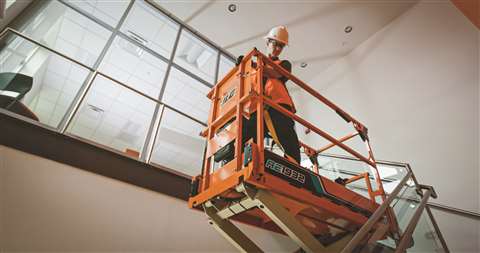 The JLG DaVinci AE1932 is a 19-foot, all-electric scissor powered by a single li-ion battery that only requires 3.5 hours to fully charge with its standard 650W charger. An optional 900W charger will charges it in 2.5 hours. Photo: JLG
The JLG DaVinci AE1932 is a 19-foot, all-electric scissor powered by a single li-ion battery that only requires 3.5 hours to fully charge with its standard 650W charger. An optional 900W charger will charges it in 2.5 hours. Photo: JLG
Electric power is taking over most new aerial work platform introductions and an array of regulatory and investor pressure to reduce construction equipment’s carbon footprint suggests that trend is here to stay.
Analysis of global construction media company KHL’s directory of new equipment introductions shows 40% of the 91 new construction machines launched in the second quarter of 2022 were electric. A third were aerial platforms. Forty-eight percent of first-quarter construction machinery introductions were electric.
Manitou, for example, is aiming for 43% of its machines to be low-emissions by 2030 with a major electric and hybrid initiative across its Oxygen series of telehandlers and aerial platforms. The company is offering electric and hybrid version of all of the new self-propelled booms it launches in 2022, and some fixed and rotating telehandlers. Manitou marketing claims customers will save more than 20% in total cost of ownership on its electric machines in the average year.
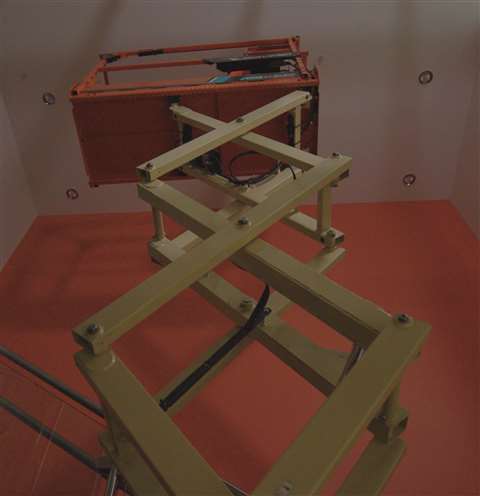 An electromechanical lift actuator on JLG’s new AE1932 DaVinci scissor lift replaces the hydraulic cylinder to eliminate leaks and refine control. DaVinci recovers energy to maximize work time between battery charges. Photo: JLG
An electromechanical lift actuator on JLG’s new AE1932 DaVinci scissor lift replaces the hydraulic cylinder to eliminate leaks and refine control. DaVinci recovers energy to maximize work time between battery charges. Photo: JLG
The industry’s commitment to an electric future begins to take shape in the context of Oshkosh (parent company of JLG) and Terex (parent company of Genie) investments in battery technology companies. In early 2021, Oskosh invested $25 million in Microvast, whose initial focus is on converting the company’s commercial vehicles. In August, Terex made a Series A investment in Acculon Energy, a developer of vehicle electrification solutions that’s willing to trade equity in its company for expansion capital.
Challenges to adoption
Perhaps the biggest challenges right now to wholesale adoption of electric power trains in more access applications are consistency in battery quality, cost and recharging infrastructure.
Equipment manufacturers often leave the certification of components that make up an outsourced assembly,
such as the certification of fuel injectors in diesel engines or individual cells in battery packs, to their suppliers. The access industry is learning that certified compliance of battery-pack components – cells and battery management system, for example – with industry standards becomes increasingly important to ensuring power train safety and quality as the systems move to higher voltage levels.
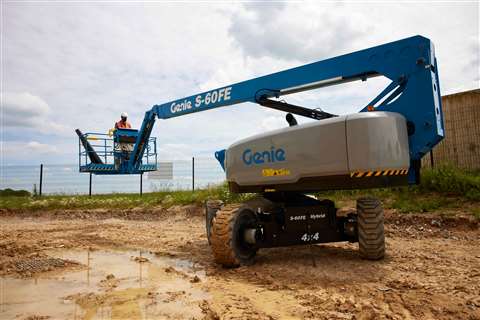 Genie’s hybrid S-60 FE combines a four-wheel-drive, diesel machine with the performance of a fully electric boom to work for a week on a single tank of fuel in hybrid mode, or all day in electric mode. Photo: Genie
Genie’s hybrid S-60 FE combines a four-wheel-drive, diesel machine with the performance of a fully electric boom to work for a week on a single tank of fuel in hybrid mode, or all day in electric mode. Photo: Genie
“Lack of qualification/certification to these industry standards may lead to system-level issues that have occurred in other industries as OEMs have rushed new product technologies, such as electrification, to the markets,” says Rob Messina, senior vice president of global product development and product management at JLG.
But despite the initial premium you pay for electric versions of scissors, booms and telehandlers with today’s mostly lithium-based batteries, the total cost of ownership is most likely much better than electric machines powered by flooded-lead-acid cells.
“Where lead-acid batteries need to be replaced every two to three years, lithium-ion batteries may not require replacement during the entire lifespan of an application,” says Andrew Thomas, Acculon president. Genie’s battery partner brings expertise in designing batteries for industrial applications and certifying their cells, battery management systems and other components to industry standards. “Every application is different, and requires special treatment of battery architecture, battery cell selection, and battery control.”
Driving access electrification
The push to electric construction machines started with government regulation, and the 2015 Paris Agreement on greenhouse gasses primed the pump on demand for electric vehicles, but manufacturers and buyers of access equipment are now increasingly compelled by several influences to clean up their equipment emissions.
“Globally, regulations are driving an increase in interest in hybrid and electric equipment, especially in countries and locations that have enacted jobsite emissions standards and where emissions levels are being monitored throughout the duration of a construction project,” says Simone Manci, applications engineer at Genie. Demand brings money, money brings supplier competition, competition brings better machines. “The cost to implement the technology is coming down, and advances in technology mean that in some cases, electrified equipment can offer better and more efficient performance.”
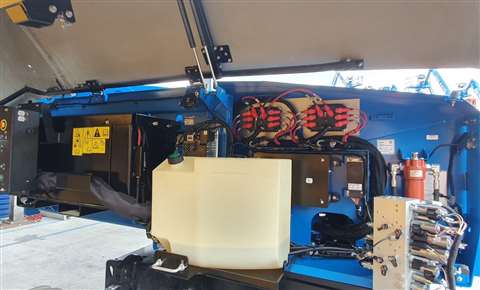 The electric side of Genie’s hybrid S-60 FE boom includes a 48V absorbent-glass-mat battery pack because AGM batteries last a long time when charged up often, perform well in a wide range of temperatures and handle the diesel hybrid’s high-current charging. Photo: Genie
The electric side of Genie’s hybrid S-60 FE boom includes a 48V absorbent-glass-mat battery pack because AGM batteries last a long time when charged up often, perform well in a wide range of temperatures and handle the diesel hybrid’s high-current charging. Photo: Genie
As we saw 15 years ago in some densely populated U.S. cities in counties that had not attained EPA air-quality standards that contract stipulations for federal projects limited total emissions that equipment on a construction project could add to the municipal air. Other vehicles and businesses were similarly limited. Of course, local jurisdictions in Europe were doing similar things to clear the air. Countries’ commitments to reduce greenhouse gas emissions in the 2015 Paris Agreement have spread limits and incentives to eliminate carbon emissions from internal combustion engines globally.
“Our customer base is getting very interested in what our portfolio, our ESG (environmental, social and governance) scores and what our Scope 3 impact looks like,” says JLG’s Messina. “A big push I have seen in the U.S. has been from ESG investors.”
The world’s top companies – including the publicly owned rental companies – are embracing sustainability as a business imperative in large part because investing in ESG stock funds has gone mainstream.
According to Bloomberg Intelligence, the value of global ESG investment assets exceeded $35 trillion in 2020 to become a third of total global assets under management. Assuming 15% growth – a third of the pace of the past five years – ESG assets could exceed $50 trillion by 2025.
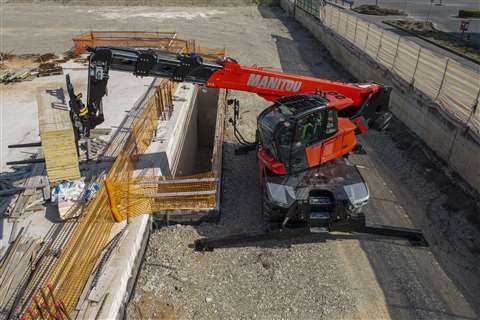 Manitou’s fully electric MRT 2260 rotary telehandler works up to four hours between charges and has a maximum load capacity of 12,000 pounds and a working height of 72 feet. Photo: Manitou
Manitou’s fully electric MRT 2260 rotary telehandler works up to four hours between charges and has a maximum load capacity of 12,000 pounds and a working height of 72 feet. Photo: Manitou
Europe accounts for half of global ESG assets and dominated the market until 2018. In the U.S., ESG investing has grown more than 40% in the past two years and is expected to exceed $20 trillion in 2022, even if its pace of growth halves.
Investing intersects directly with electric equipment models in how companies qualify as ESG stocks. Part of the process is to report their carbon emissions in sustainability reports. Investors have begun demanding carbon reporting as the investment world finds that companies who report and reduce carbon emissions are often better investments. Also, more investors are sensitive to the impacts of climate change and are shifting investments to ESG assets.
One of three scopes into which corporate carbon emissions are categorized, Scope 3, is for indirect carbon. For manufacturers, that includes all of the emissions from the products they produce throughout the life of those products. So publicly traded equipment manufacturers are striving to reduce carbon emissions from their machines to attract investors.
“The DaVinci (JLG’s all-electric AE1932 scissor lift) uses 70% less energy than a conventional electric scissor, so that means it consumes less power off the grid to keep charged – this is a huge benefit to Scope 3,” says Messina. “Scope 3 reductions are going to be a big part of the next 10 years. Having more efficient solutions that use less energy will be a big driver in our industry as public companies get more and more sensitive to their ESG.”
Scope 3 is particularly important to access equipment makers because the indirect carbon emissions from use of their products, typically measured by their energy consumption, represents as much as 85% of their companies’ total carbon emissions. Making more efficient machines is the biggest lever they can use to improve their sustainability reports. And the refined controllability of an electric power train, compared to one powered by internal combustion, makes an electric machine do the job not only without producing local emissions but also requiring less energy, which reduces its total carbon emissions.
“There’s another trend out there: we talk about the new societal deal. A lot of the folks coming into the workforce now are demanding better awareness of their impact to the planet,” says Messina. “And that is a huge variable in this equation.”
So the driving forces behind today’s rapid electrification effort are much bigger than government regulation. There’s undeniable demand among key stakeholders in the access equipment industry – investors, employees, customers – for more sustainable products. As increasingly efficient electric machines log hours in the field, a growing body of evidence suggests that they are a better investment for their owners and users.
Why new electrics access equipment is better
Demand for more environmentally friendly machines combined with operating costs associated with increasingly complex internal combustion engines are accelerating buyer adoption of the new generation of electric access equipment in rough-terrain-scissor and other applications that have not typically been electric.
“As an engineer, it’s easier to develop an electric product than one powered by an internal combustion engine,” says Messina. “There are fewer moving parts. How we manage efficiency is more straightforward.”
Electric power trains are simpler and more cost-effective to maintain on the job than those powered by internal combustion. For example, Snorkel says its A46JRTE fully electric articulating boom lift reduces battery and electrical-system maintenance enough to drop servicing costs up to 93% compared to a standard engine. A big chunk of that reduction is labor, and eliminating the boom’s engine and hydraulics eliminates the costs and risks of waste oil and filter disposal.
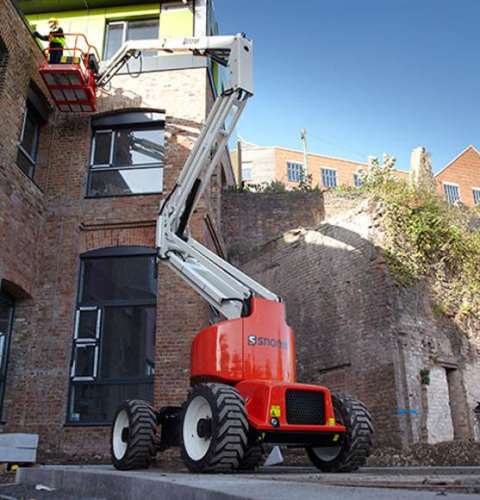 Snorkel says the lithium-ion batteries in its A46JRTE electric articulating boom reduce battery and electrical system maintenance enough to drop servicing costs up to 93% compared to a standard engine. Photo: Snorkel
Snorkel says the lithium-ion batteries in its A46JRTE electric articulating boom reduce battery and electrical system maintenance enough to drop servicing costs up to 93% compared to a standard engine. Photo: Snorkel
Today’s sealed, mostly lithium-based batteries also circumvent the significant investment in labor to maintain the water levels in the battery cells and the performance limits inherent in electric lifts that have drawn power from flooded lead-acid batteries (FLA) since early electrification.
“Flooded lead-acid batteries require regular maintenance, that unfortunately gets ignored frequently resulting in battery failures and reoccurring replacement costs,” says Corey Connolly, product manager, Skyjack.
Incidental benefits of today’s sealed batteries include eliminating the risk of acid spills and outgassing, which makes them better suited for work in environmentally sensitive areas like clean rooms, data centers and hospitals. These particular segments of the construction economy have proven resistant to recent slowdowns in construction spending, so some equipment makers are careful to offer products that extend those benefits.
And the chemistry of today’s lithium-based batteries offers inherent performance advantages.
“With a high energy density, lithium-ion batteries are able to discharge more stored energy than lead-acid batteries, making them more efficient,” says Matthew Elvin, CEO of Snorkel. “Lithium-ion batteries have a better depth of discharge and can be used at a higher capacity before recharging.
“Since lithium-ion batteries have a higher efficiency, they can handle a higher amp to charge faster than lead-acid batteries. The closer to full capacity, the slower lead-acid batteries need to be charged to avoid overheating. Additionally, not fully recharging lead-acid batteries could reduce their overall lifespan.”
The amount of work time on a charge is the result of a complex equation that includes average duty cycle derived from a span of likely applications, expected recharging infrastructure, a target cost range that buyers will pay or total cost of ownership (TCO) they will appreciate and more factors. The length of time a machine will work between charges varies but dealers can help you narrow the range.
Lithium-ion batteries powering Snorkel’s all-electric SR626E compact telehandler, for example, can operate continuously for up to six hours between charges, depending on the conditions, and an on-board charger offers full overnight charging.
Time required to recharge is another important productivity factor that is easier to nail down, and lithium-based batteries deliver dramatic recharging advantages over FLA batteries.
“Most hydraulic-drive, as well as some electric-drive, scissor lifts on the market have a battery charge that lasts just a single shift – and takes eight to 10 hours to completely charge. That means that nearly half a day, the machine is not usable,” says Bob Begley, director of product management for scissors and vertical lifts at JLG. “Some scissor lifts powered by a lithium-ion battery (or multiple li-ion batteries) can go from not charged to fully charged in much less time. For example, it only takes 3.5 hours for the single lithium-ion powered JLG DaVinci lift to fully charge with its standard 650W charger. With an optional 900W charger, it fully charges in 2.5 hours, making the machine usable for 20+ hours each day. Over the course of those 20 hours, the lithium-ion battery offers no performance degradation, unlike their FLA battery counterparts, which degrade as the percent of charge decreases.
“Lithium-ion battery technology offers opportunity charging. For example, with as little as 30 minutes of charging, the JLG DaVinci scissor can provide up to a couple hours of power for users to finish their work without damage to the battery. And with its quick-charge feature, in as few as five minutes, the lithium-ion battery can be charged enough to drive the machine 100 feet with enough torque to load it onto a truck.”
About electric lifts’ price
The price premium paid for new-generation electric machines – a significant issue in their adoption – had been coming down steadily in the years leading up to the pandemic. While operating conditions have a huge impact on total cost of ownership, reduced maintenance and much longer battery life suggest maintenance-free lithium-based power systems do produce a significant TCO advantage today.
“There are a lot of changing dynamics at work,” says Messina. “Lithium-ion has had great reduction in acquisition cost in the past ten years. Today, I would characterize the price of FLA batteries as 1X, AGM (absorbent glass mat) is 2X and lithium-ion is 4X.”
Eliminating the need to routinely top off battery cells with water not only saves a tremendous amount of labor over the life of a machine but eliminating the chance for maintenance errors also ensures that sealed lithium-ion batteries last longer.
Lithium batteries’ longer design life is already a significant factor in the TCO comparison. Lead-acid batteries average two- to three-year lifespans. Lithium-based batteries are generally designed to last the life of the machine, sometimes seen as a seven-year proposition.
In the current global economy, surging electric-vehicle demand supplements lingering pandemic-effect supply chain disruptions that drive the cost of lithium-ion batteries. Current conditions notwithstanding, growing demand is expected to continue spurring component-manufacturing competition and continue driving down the cost of lithium batteries and electric machines.
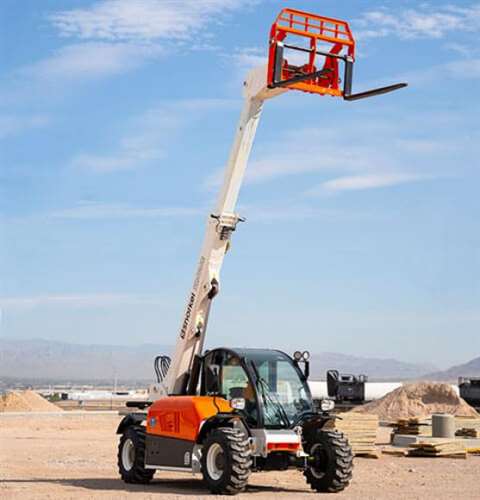 Snorkel entered the all-electric compact arena with the SR626E telehandler, with load capacity of 5,730-pound and 19-foot lift height. Photo: Snorkel
Snorkel entered the all-electric compact arena with the SR626E telehandler, with load capacity of 5,730-pound and 19-foot lift height. Photo: Snorkel
“We’re getting close to affordability,” Messina says. “In general, consumer products trend towards conversion when product premiums are 25% to 30% above,” the established product’s price. “We still have work to do. And while battery cost is the elephant in the room, lithium-ion power allows us to reduce total system cost.”
The system innovation that’s hard to ignore today is replacing machine hydraulic systems with electric actuators – as in JLG’s all-electric DaVinci scissor, Snorkel’s SR626E telehandler and A46JRTE articulating boom, Manitou’s MRT 2260 rotating telehandler and an expanding roster of all-electric access equipment. Manufacturers say the change can cut cost over the life of the machine by more than 40%.
Acquisition cost remains a challenge, as there are few component suppliers who make linear actuators at the scale and power necessary to lift construction loads to height. But again, increasing demand is drawing competition that is pushing prices down.
“It’s a progress we need to see,” says Messina. “You gain fidelity of control, you cut your total cost of ownership almost in half. Your energy efficiency goes way up, so your power consumption goes way down, which means great improvements in your Scope 3.”
“As we see more manufacturers and industries go this way the ancillary markets will grow. We saw that with motors. There are lots of folks making motors now, whereas 20 years ago we didn’t have a buffet, so to speak, of available suppliers. Now every supplier out there is looking at an electrified future. It’s been a mega trend for at least the last six years. I think as we get more and more widespread adoption (of electric actuation), we’ll see these price points come down to that 25% to 30% premium and this will start to make a lot of sense.”
Where to charge?
Equipment makers agree the lack of charging infrastructure for electric access equipment, particularly in the early stages of construction or in remote locations, is one of the biggest challenges threatening adoption.
“Hybrid booms really are a good step for jobsites that aren’t ready for full electrification,” says Zach Gilmor, Genie product manager, “They’re also a good solution for jobsites that want the ability to keep one machine onsite from the start of construction, before there is electrical infrastructure to support charging batteries, until the end, when the machine is needed indoors.”
Introduced about six years ago, Genie’s range of FE hybrid booms combines the benefits of a four-wheel-drive, diesel machine with the performance of a fully electric boom. The FE machines can work for a week on a single tank of fuel in hybrid mode, or all day in quiet, zero-emissions electric mode. They will run on diesel power exclusively if their batteries are fully discharged, and in hybrid mode, their control system keeps the batteries charged using regenerative braking technology and automatic engine start and stop.
Genie’s FE hybrids use AGM batteries because they work well when they are fully recharged as often as possible, perform better under varying temperature conditions, and can handle the high-current charging delivered while the machine works in hybrid mode. Their ability to handle high-current charging allows for a rapid recharge in less than 2.5 hours.
Tightening regulations in some urban areas are requiring use of zero-emissions vehicles that will exclude hybrids. We see these mandates in some European city centers. The California Air Resources Board took the first step to this kind of regulation on a large scale by approving the Advanced Clean Cars II rule in August. The rule establishes a roadmap to requiring 100% of new cars and light trucks sold in California to be zero-emission vehicles by 2035. Fifteen other states that currently follow California’s vehicle rules are expected to adopt these regulations through their own rulemakings. Advanced Clean Cars II doesn’t apply to industrial vehicles like access equipment, but these rules demonstrate that more vehicle-specific regulation is possible.
The likelihood of lower operating costs and more flexible and less labor-intensive machines can ease the strain of transition to electric access equipment. Dynamic electric vehicle technology propelled now by competition for the growing demand, the ownership proposition should only grow more attractive. For example, JCB invested in a clean-hydrogen supplier and has shown a prototype hydrogen-powered backhoe, telehandler and excavator. There are more innovations to come.
Want to read this story in print? Check out the full version of this story in the September/October issue of Scaffold & Access Magazine.
STAY CONNECTED




Receive the information you need when you need it through our world-leading magazines, newsletters and daily briefings.
POWER SOURCING GUIDE
The trusted reference and buyer’s guide for 83 years
The original “desktop search engine,” guiding nearly 10,000 users in more than 90 countries it is the primary reference for specifications and details on all the components that go into engine systems.
Visit Now
CONNECT WITH THE TEAM









